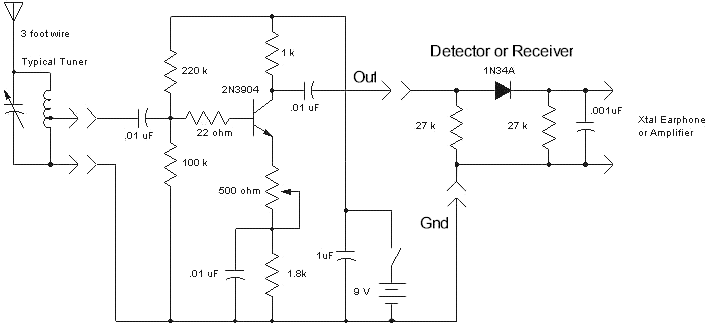Experimenting with crystal radio, I've reach a point where I'm not able to understand the explanations about antenna and tune coils coupling, and impedance matching.
Most radios use a step up coil scheme, where the antenna coil has fewer turns than the tune coil (where the resonance is achieved, using a variable capacitor).
But most loop antenna based radios do the opposite.
Just picking two references:
------
"The impedance of the signal coming from the antenna is probably in the 50-300 Ω range. Crystal radios are usually listened to with high impedance headphones, usually around 2 kΩ. Having a 100 Ω source driving a 2 kΩ load is inefficient, which ultimately means lower volume...
[a] transformer steps up the voltage, making it higher than what comes out of the antenna directly."
------
If stepping up voltage, that means the antenna "sees" the diode side as a lower impedance than it really is.
------
"The basic circuit consisting of the diode, load resistor and the smoothing capacitor will never present a good match to 50Ω
If the detector diode is in its on state, the circuit will appear to be less than 50Ω.
To overcome this issue it is normal practice to use an impedance transformer to step up its impedance."
------
This contradicts the previous statement. Is the diode side a high or a low impedance?
Most radios use a step up coil scheme, where the antenna coil has fewer turns than the tune coil (where the resonance is achieved, using a variable capacitor).
But most loop antenna based radios do the opposite.
Just picking two references:
------
"The impedance of the signal coming from the antenna is probably in the 50-300 Ω range. Crystal radios are usually listened to with high impedance headphones, usually around 2 kΩ. Having a 100 Ω source driving a 2 kΩ load is inefficient, which ultimately means lower volume...
[a] transformer steps up the voltage, making it higher than what comes out of the antenna directly."
------
If stepping up voltage, that means the antenna "sees" the diode side as a lower impedance than it really is.
------
"The basic circuit consisting of the diode, load resistor and the smoothing capacitor will never present a good match to 50Ω
If the detector diode is in its on state, the circuit will appear to be less than 50Ω.
To overcome this issue it is normal practice to use an impedance transformer to step up its impedance."
------
This contradicts the previous statement. Is the diode side a high or a low impedance?

 ...
...


